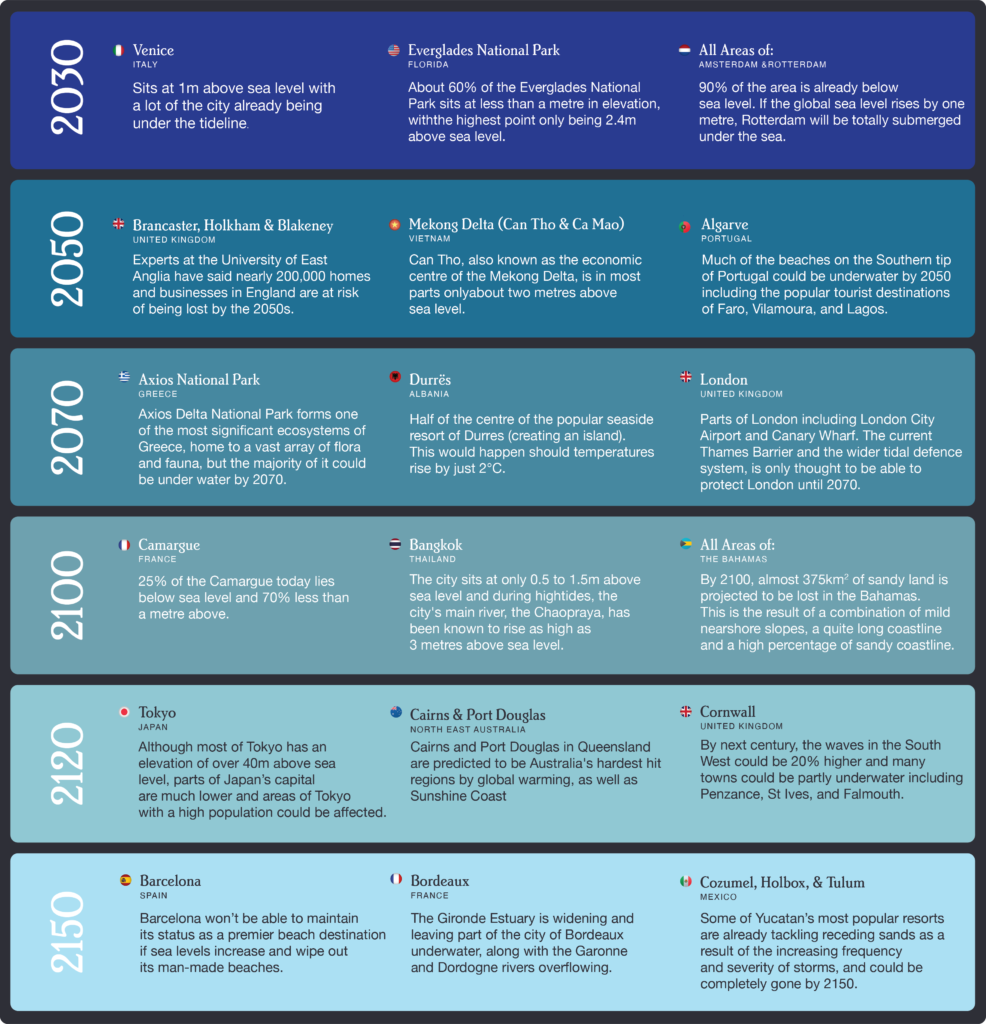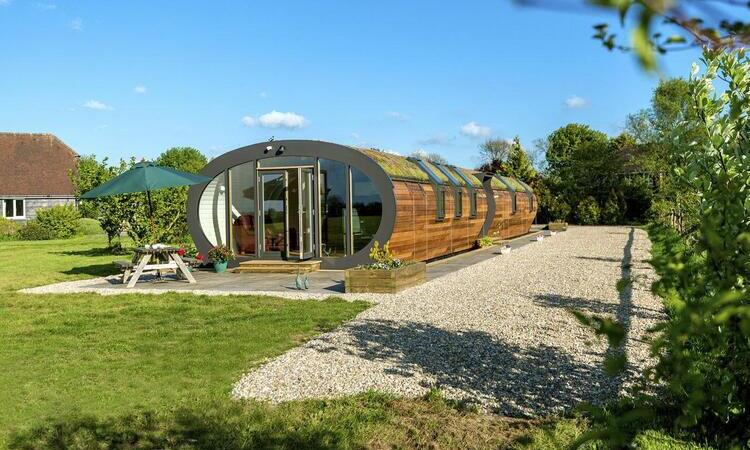Guest post by Amelia Selby
As predicted, ‘revenge travel’ is in full swing post-pandemic. People are travelling more than ever: travelling for longer and more frequently with a reinvigorated urge to discover new places or revisit past favourites.
However, recent natural disasters – forest fires, flooding, and droughts – have really emphasised the climate crisis and highlighted what is to come if we don’t change our ways. At Oliver’s Travels, we have looked at research that highlights the most ‘at risk’ areas around the world, those that are predicted to see the highest impact by climate change before the next decade.
Using this data, we have created a set of before and after images – that can be viewed using a helpful scroll tool – to highlight the devastating impact that global warming may have on some of the world’s top holiday destinations within this decade.
So, what might some of our favourite travel destinations look like in the next 10, 50, 100 years?
Cornwall, United Kingdom
[bafg id=”57907″]
A much-loved staycation destination, Cornwall risks its tip being cut off completely and becoming an island if sea levels continue to rise as they are at present. It is thought that in less than 200 years half of Penzance and most of Hayle could be underwater, Climate Central reveals.
Yet changes are likely to be noticed across the region within the next decade if carbon emissions are not curtailed. In fact, before the end of this decade, with only a 0.5m rise in sea levels, Cornwall’s waterways and rivers will get much larger and inundate surrounding fields, commercial properties and residential areas.
For example, Newquay’s much-loved Fistral Beach could be lost by sea levels rising by as little as one metre.
Below, you can see just how much difference this amount of erosion could have on the tourist hotspot, with its beautiful sandy beach flooded completely.
Thessaly, Greece
[bafg id=”57912″]
One of the most popular travel destinations in the world, Greece is not short of visitors flocking to see its picture-perfect towns, white sandy beaches, and breathtaking coastlines, with as many as 27.8 million tourists visiting last year.
But global warming is having a devastating impact on the country, with a wildfire in northeastern Greece burning for 11 days at the end of August 2023 and completely destroying an area larger than New York City according to an article in Reuters.
The country is set to experience heatwaves a lot more frequently in the coming years too. In the best case scenario, the number of heatwaves each year will rise to six on average, an increase from 1.4 in 2000, studies reveal. Reduced rainfall will also result in the loss of agricultural land but also in more forest fires.
In the image below, you can see how Greece could look in the summer months with much of its greenery charred as a result of soaring temperatures and fires.
Venice, Italy
[bafg id=”57916″]
Venice is one of those bucket-list travel destinations. Many people wish to experience the magic of its 120+ islands, 177 canals, and 391 bridges – all connected by a maze of tiny streets and hidden squares.
However, the ‘City of Water’ could be permanently flooded in the very near future if sea level rise continues at the current rate.
By the end of the century, a four-degree°C temperature increase could see a sea level rise of 180cm, the BBC has reported. Worst-case scenario, this would see the city disappear beneath the waves with the lowest part of the iconic St. Mark’s Square being just 55cm above the current average sea level.
The comparison below shows what St. Mark’s Square could look like by as soon as 2100.
Barbados, Caribbean
[bafg id=”57914″]
Even on the other side of the world, climate change is still set to cause damage. By 2100, sea level in the Caribbean is expected to rise by as much as 1.4 metres. A worrying statistic considering that more than 50% of the population live within 1.5 km of the shore.
This rise in sea level will impact coastal communities, with it being expected that between 29 and 32 million people may be affected. Primary sources of income, including tourism, will also be impacted due to the majority of the main tourist attractions, such as beaches and hotels, being near the coast.
Often the sight that conjures up in your mind when you think of a tropical paradise – white sandy beaches, crystal clear water, and balmy weather.
Below, you can see what an impact global warming could have on the Caribbean’s beautiful coastline, which draws back millions of tourists year after year.
Which destinations will we lose over the coming years if we don’t change our ways?
Those images are pretty shocking, right? But they’re not the only travel destinations that we stand to lose in the coming years if global warming continues at the rate it is.
Below is a timeline of the worst-case scenario, and the destinations and landmarks that are predicted to be under tideline in the coming years.

Tips for reducing your carbon footprint when on holiday
Of course, this is not to say that we should stop travelling altogether, but it is imperative that we do what we can in order to keep our carbon footprint as low as possible when going on holiday.
That’s why we’ve put together some tips for travelling more sustainably – whether you’re staying close to home or visiting somewhere more far-flung.
Staycation Suggestions
- Be selective with accommodation

Before deciding on your accommodation, look at and analyse its eco-credentials. For example, we have a bespoke section on our website that outlines the most environmentally friendly properties available. If you can’t find any information online about your desired accommodation’s eco-initiatives and credentials before booking, it is always worth contacting them directly as they should have this information to hand.
- Eat seasonally
Eating foods when they are naturally in harvest means that you will be consuming produce that is grown in natural sunlight rather than in a CO2-emitting greenhouse. By doing this, you will also be reducing your carbon footprint, with air travel being the primary method for transporting produce where it is out-of-season. If you’re eating out, look out for restaurants that offer a special seasonal menu. Not only will you be reducing your food miles and helping the environment, but you will also be consuming food that is fresher, more nutritious, and tastier!
- Leave no trace – exploring the countryside
Often, staycation breaks mean exploring the beautiful English countryside but when doing this, remember to leave no trace. For example, many of the properties we work with are in areas of natural beauty, which is why people visit them, so it is important that we ensure that they remain areas of natural beauty for the future. When having a picnic, make sure that you don’t sit somewhere that will disturb the wildlife or damage the landscape. And when you leave, double-check that you’re taking everything that you brought with you. Especially any plastic rubbish.
European Tips
- Forego air travel – if you can
Of course, the best way to reduce your carbon footprint is by foregoing air travel. For example, a family of four going on holiday to Avignon in France would emit around 1,218kg of CO2 emissions from the flight and hotel rooms alone, with this rising by another 218kg if food is all-inclusive. Yet, by taking the Eurostar instead, the travel emissions are cut by a huge 93% to 72kg. We also offer properties with a footprint as low as 24kg of CO2 per week, which is almost four times lower than that of the average hotel stay!
- Stay in a villa rather than all-inclusive

As mentioned, staying in a villa can greatly reduce your carbon footprint. We even launched a Slow Travel Package last year that offers a more sustainable approach to travel by increasing contributions to the local economy and community whilst also reducing the environmental impact of our holidays. Highlights include a local cooking class where you can learn to cook regional dishes, books at the property about the destination to give you a deeper appreciation of its culture, and a fridge stocked on arrival with all items being fair-trade, organic and sourced within a 50-mile radius so that you really get a taste of your travel destinations.
- Hire an electric car when in Europe
Searches for hiring a car abroad have increased this year compared to last, so anyone considering renting a vehicle when abroad should look at electric ones in order to reduce their carbon footprint. It’s easier than ever too with Statista reporting that between 2020 and 2023, the number of public electric vehicle charging stations in Europe has almost doubled.
Long-haul How-Tos
- Fly direct
We know that it is very difficult to completely avoid air travel and sometimes you have no option but to take a flight. However, to keep emissions lower in this instance, take direct flights where possible, even if it means paying more money. Take off and landing is where the most fuel is used throughout your journey so limiting this is a good way to cut down your emissions. Plus, a flight with no layovers means the shortest distance between two points and therefore the smallest amount of fuel needed to get you from A to B.
- Choose airlines committed to making a difference
Some airlines are fighting harder against climate change than others so seek out and fly with those that are. For example, KLM has a set goal of reducing its total carbon footprint by 2030. It powers its hub airport in Amsterdam 100% on sustainable fuel sources and, after completing its first commercial flight with biofuel in 2011, KLM now uses 57 times more biofuel today than it did. Alaska Airlines has reduced its emissions by 16% in the last 10 years by split scimitar winglets (reducing drag) and new navigation technology that leads to more direct flying.
- Favour new fleets
Favour newer fleets to cut emissions. Newer aircraft types like the Airbus A320neo and Boeing 787-9 emit between 30% and 50% less CO2 per kilometre travelled by paying passengers (RPK) than the most inefficient legacy aircraft according to research. Also, consider the size of the plane too, and avoid flying on either very small or very large planes where possible. Smaller regional aeroplanes that are used for shorter flights emit nearly 80% more CO2 per RPK than the global average for all aircraft.
What are we doing at Oliver’s Travels?

We began our sustainable journey back in 2020, as part of our goal to become a net-zero company in our London office. We’re happy to say that we have achieved exactly that!
Partnering with Tree-Nation, we are on a mission to plant enough trees to offset 110% of the CO2 emissions of every villa holiday booked with us.
So far, we’ve planted enough trees (over 16,000 of them!) to offset 1386.74 tonnes* of CO2 emissions, which we’re super proud of.
We’ve also been working with a sustainability expert to audit our entire portfolio of properties – right from air conditioning and electricity usage to waste management systems and recycling rates. Analysing also the size of the property, its most popular season and the national energy suppliers’ fuel mix.
Why? Well, travel and tourism contribute to around 8% of the world’s total greenhouse gas emissions.
As a travel business, we can’t ignore this fact and believe that we must play our role in reducing this number.
Oliver Bell, Founder of Oliver’s Travels, explains: “We believe in doing more and finding extraordinary, which is why we are committed to becoming the most environmentally progressive villa company in the world. By making responsible decisions and taking urgent action, our goal at Oliver’s Travels is to become net zero and be a force for positive change in the travel industry, as well as our wider communities.”
*Figures correct at time of publishing, subject to change.
This is an idea of what our favourite travel destinations could look like in 100 years if we keep on emitting carbon and polluting at current levels. Now, we don’t want to stop people from enjoying seeing our world, that’s why we list a whole collection of Sustainable holiday villas and we show you how to travel to them in a more eco-conscious fashion. That way, if we reduce our individual impact that travel causes, these extraordinary destinations will stay the way they are for generations to come. Check out the full portfolio on Oliver’s Travels and contact our concierge team for help choosing a sustainable stay, tips and local knowledge and booking some eco-activities while you’re away.




Leave a Reply